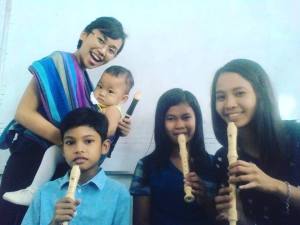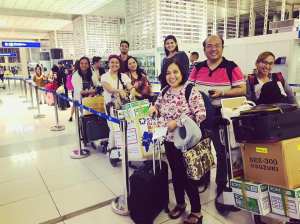“Oh, asan ang mga anak mo?”
(“Where are your kids?”)
People at my workplace would often be surprised if I came in with just a bag. Sometimes, I think they would fail to recognize me without my “baby in a bag”. Actually, people would stop to greet NOT ME but my kids, recalling how one used to be just so small, stuck “in a blanket on my chest”, or that now, I have one running little girl and another little one on my “front pack”.

The fanged apex predators are gone but moms have to survive mountains of living laundry that never die! (babywearing gear: Quality Brand (QB) polyblend wrap, size 6) [photo: JZBCarranza]
Today, caregivers have a lot of safe babywearing options to choose from, most of which are made from textiles such as cotton, bamboo, and/or linen. One just needs to do thorough firsthand and secondhand research. It can be as simple as a long piece of woven wrap or sophisticated as a soft-structured buckle carrier with little pockets. Long before the modern branded carriers came, babies were worn using pieces of cloth found at home. Towels and blankets came in handy. In traditional societies, babies were even worn using cradles and baskets!
There is much to say about babywearing – how it has become an “expensive” industry to which babywearing moms like me could attest to; the safety standards concerning ergonomics and the physical development of the child; cultural appropriation; and other attachment parenting practices closely connected to it, such as breastfeeding and safe co-sleeping. With all the issues surrounding babywearing, I can speak most confidently about how it has helped us level the field between husband and wife.
Babywearing has been the greatest equalizer in our family. It has helped us raise our children without the need for a mainstay nanny. Although there are times that we leave our children with extended family members, our children mainly stay with us, me in particular. I have never stopped working and studying even through childbearing and childbirth, except perhaps for a few days after I gave birth.

Newborn wrapping and Toddler carrying: 4 days after giving birth to our 2nd child, we had to go back to the hospital for our newborn’s BCG shot. After this, we went to the grocery for a quick errand. Wrap used for newborn: QB; Soft-structured carrier used for toddler: Ergobaby Galaxy
Babywearing is just a part of the entire philosophy that our family decides to live by everyday: gender equality. The Philippines is still a largely patriarchal society but little improvements happen. Women are still expected to be the primary caregivers and a career outside the home is difficult, especially with the lack of dependable childcare options. Although inequalities are still present, women in the Philippines are given more opportunities to pursue studies and a career outside the home. I consider my workplace, also where I am currently finishing my Master’s thesis, to be somewhat child and family friendly. With babywearing, I am able to teach my students while attending to the needs of our child, especially feeding concerns. While bottle feeding stored breastmilk worked for our first child, our second child would not want to bottle/cup feed.

What break?: I checked on my class a few weeks after giving birth. (babywearing gear: Shadrach’s Collection Hiraya ringsling) [photo: N.Lee]

Linggo ng Wika: Playing the saggeypo, a set of bamboo pipes, with student-teachers from the UP College of Music. (babywearing gear: Ergobaby Adapt) [photo: C.A.Yson]

Photo with the workshop participants on the last day of the PSME-NCCA National Workshop for Music Teachers (babywearing gear: improvised sling (rebozo tie) using kroma, a Cambodian traditional scarf) [photo: K.Abesamis]

Photo with Recorder Ensemble students of the Open School of Music (OSM), an outreach program pioneered by Mrs. Engracia Lim and the UP College of Music, Music Education department (babywearing gear: QB)
When it comes to public spaces and transportation, there are courtesy lanes/areas that accomodate PWD, senior citizens, pregnant women, and adults with small children, although there needs to be more consistency in implementation. Babywearing has helped us get through the daily commute in Metro Manila and even outside the Philippines. While it is not the safest option when riding vehicles, it has given us mobility, especially when people do not honor courtesy area assignments.

Riding the tricycle on the way to school (babywearing gear: Ergobaby Galaxy)

Midnight flight to Iloilo for a workshop with the Philippine Society for Music Education (babywearing gear: Ergobaby Adapt) [photo: Philippine Society for Music Education]

Morning trek around Angkor Wat (babywearing gear (L-R): Ergobaby Galaxy, Ergobaby Adapt)

Breastfeeding while touring Piazza San Marco (babywearing gear: Ergobaby Galaxy) [photo: Issay Rodriguez]

Z, doing a module on identifying emotions using color-coded handbells at Food for the Hungry, Siem Reap, Cambodia, a project w/ TCCP-DFA Philippines. (photo: Elijah N.)

Demonstrating how to hold the recorder to children from different villages in Siem Reap, Cambodia, with Food for the Hungry staff Minear as my translator. (babywearing gear: Ergobaby Adapt) [photo: Zea M.]
(“Isn’t she heavy? You carry her all day.”)

QB polyblend woven wrap as hammock in the office
People often ask me variations of this question, especially upon carrying my baby as a way to help me balance my bags or just for the heck of carrying a baby. If anything, babywearing has not made it equal for everyone in the family but it has equalized our playing field. I realized this on the first day I left my children at daycare and school – I was free. I basked in the freedom of walking to my workplace seconds faster than my usual pace, almost tiptoeing every step in delight. Yet, even with additional kilograms every time I go to work, I am still thankful I am able to work, study, and go to some of the usual places I visit when it was just only me.

Fast toddler backcarry using QB woven wrap after a long day of missing my toddler (first try, need to improve tightness)

Doing errands around the University with a newborn (don’t worry, morning sun) in Shadrach’s Collection Hiraya Ring Sling [photo: Issay Rodriguez]
I’m inspired. Malapit na rin ako magresume for work and wala p yaya, I hope I can bring my baby to work din.
LikeLiked by 1 person